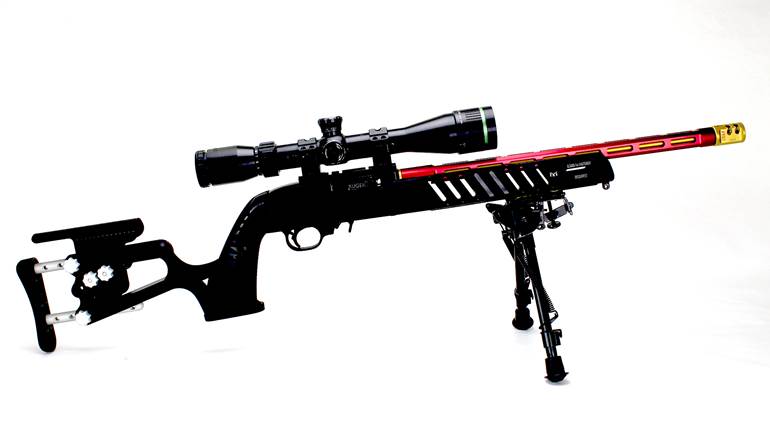
It’s hard to believe, but a 50-round load development can be one of your most time-consuming range days. Now, I bet you’re reading this and thinking to yourself, “That’s not very many rounds; how can it take so long?” Well, the answer doesn’t lie in the shooting; it lies in the cooling. Shot placement and overall accuracy almost always changes with barrel temperature, which is why we want to keep it as cool as possible without allowing it to return to cold-bore conditions. This ensures a consistent environment and also protects against warping and eroding this critical component.
There are many ideas as to what the threshold for heat should be, as well as how to measure it. Short of bringing a laser thermometer to the range, I have found the simple tap-and-grab method to suffice for most applications. After five shots, tap your barrel to see if it's approaching critical temperature. If you can tap it, next, see if you can comfortably grab hold of it. If you can hang onto it, shoot another five. If not, lock the rifle’s bolt to the rear, ensure it is unloaded, place it in the shade, and wait. Don’t worry; there are plenty of worthwhile activities to keep you busy. Here are the five that are at the top of my list:
Load Development
Building ammunition at the range isn’t the hardest thing to do. A simple hand press, powder scale, trickler, and funnel are all that is required. It’s likely that you have most of this equipment already, so why use up valuable time at home? Prior to your range day, size, prime and flare (if applicable) a handful of extra cases before heading out the door. Then, charge a set with the next powder increment and seat a bullet while your rifle is taking some shade.

This is also an excellent way to save components and ensure that you don’t wind up with loads past your sweet spot. Should something go wrong along the way, this also provides a method of re-shooting a group you might have flubbed. I am fortunate enough to have a shed on the firing line that I thoroughly use to my advantage. In preparation for firing the next group, I roll off three rounds of a given load, and if I like where it’s going, I quickly whip up two more to see if my five-shot group is in a contest for the tightest.
Case Prep
There is nothing more boring than case prep, except maybe hovering over a hot gun and waiting for it to cool down. So, why not combine two mundane tasks? A chore like uniforming the primer pocket of 1,000 pieces of brass is much easier to swallow when you’re enjoying some temperate weather and relaxing at the range.

Many companies offer cordless case-prep tools that still allow you to power the operation when on the go. If that doesn’t seem like a worthwhile investment, there is also the option of running a power inverter from a 12V source. Conducting these tasks at the range also limits the amount of lead you might deposit on your home workbench, which is also a terrific benefit.
Shooting Other Guns
The funny thing about firing a half-dozen rounds downrange; it only warms up one gun in your collection. Therefore, if you bring a few others, you’ll have no trouble occupying dead time. I still believe in breaking in barrels, which also requires a cooling period. Often, I’ll shoot a gun that I am breaking in in tandem with one that I am doing load development for.

This allows me to work on one while the other cools, filling up that gap and essentially doubling my productivity. If purchasing a new gun isn’t in my recent past, this is also a great opportunity to zero or confirm zero on an optic, or even just plink away with a .22LR for fun. It's almost like getting a free day at the range.
Gather Brass
With all of the work that goes into cleaning, sorting and accurizing brass, I like to get as much back as possible. When shooting an semi-automatic, that’s easier said than done. Sure, I can wait until the end of the day to try to unearth that last piece, or I can do it while my barrel cools.

During load development, I need to observe this brass anyway, as it becomes the looking glass into pressure issues that might be developing. It’s also far easier on the back and knees to do this in short spurts as opposed to bending over for extended periods. Put what you find upside down in an MTM case, and you’ll never have to worry if you’ve recovered them all or have to waste time counting.
Range Maintenance
While you’re down there, you might as well pick up the other junk that is far too often left behind. If your range doesn’t recycle, keep the other guy’s brass for yourself and bring it to the scrap yard. I’ve purchased firearms with the money I’ve earned by cashing in what others have left behind. I’m not selective in the process, either. While I’m hunched over, I bag up everything I walk past, regardless of value.

As members, it’s up to us to take ownership; it’s our range, and I want it to look good. Maintenance efforts do not have to be limited to janitorial duties, as larger tasks can be broken down into digestible segments that allow you to fire off groups in between. I once repaired a dozen shooting benches along the course of load development, leaving both my groups and the firing line a better place.





































